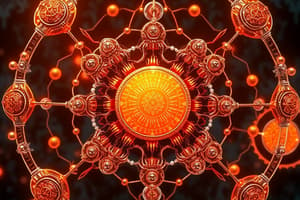Podcast
Questions and Answers
In the context of semiconductor device engineering, what is considered the fundamental basis?
In the context of semiconductor device engineering, what is considered the fundamental basis?
- Controlling the movement of electrons in solids. (correct)
- Utilizing magnetic materials in electronic devices.
- Enhancing the optical properties of semiconductors.
- Focusing solely on silicon-based devices.
Which atomic model introduced the concept of quantized energy levels for electrons?
Which atomic model introduced the concept of quantized energy levels for electrons?
- Bohr's Atomic Model (correct)
- Dalton's Atomic Model
- Thomson's Plum Pudding Model
- Rutherford's Atomic Model
In the Bohr model, what happens to the energy difference between successive energy levels as 'n' increases?
In the Bohr model, what happens to the energy difference between successive energy levels as 'n' increases?
- The energy difference remains constant.
- The energy difference increases.
- The energy difference fluctuates irregularly.
- The energy difference decreases. (correct)
What does the vacuum energy ($E_{vac}$) in the context of semiconductor physics represent?
What does the vacuum energy ($E_{vac}$) in the context of semiconductor physics represent?
What primarily determines the radii of the electron orbits in the Bohr model?
What primarily determines the radii of the electron orbits in the Bohr model?
What is the primary characteristic that defines a material as a compound semiconductor?
What is the primary characteristic that defines a material as a compound semiconductor?
In a crystalline solid, what does the conduction band represent?
In a crystalline solid, what does the conduction band represent?
What happens to the electron concentration in a semiconductor when it's illuminated with light?
What happens to the electron concentration in a semiconductor when it's illuminated with light?
What is the significance of the Fermi level in semiconductor materials?
What is the significance of the Fermi level in semiconductor materials?
How are extrinsic semiconductors created?
How are extrinsic semiconductors created?
What type of semiconductor is formed when a semiconductor material is doped with donor atoms?
What type of semiconductor is formed when a semiconductor material is doped with donor atoms?
What distinguishes a degenerate semiconductor from a non-degenerate one?
What distinguishes a degenerate semiconductor from a non-degenerate one?
What is a 'hole' in the context of semiconductor physics?
What is a 'hole' in the context of semiconductor physics?
What is the effect on electron mobility if the temperature of a semiconductor increases significantly?
What is the effect on electron mobility if the temperature of a semiconductor increases significantly?
What causes diffusion current in a semiconductor?
What causes diffusion current in a semiconductor?
What are the two primary types of current flow in semiconductors?
What are the two primary types of current flow in semiconductors?
Which of the following best describes the relationship between electron and hole drift in an electric field?
Which of the following best describes the relationship between electron and hole drift in an electric field?
What effect does increasing the impurity concentration in a semiconductor typically have on carrier mobility?
What effect does increasing the impurity concentration in a semiconductor typically have on carrier mobility?
In the context of semiconductors, what is 'carrier generation'?
In the context of semiconductors, what is 'carrier generation'?
What is the 'minority carrier lifetime' in a semiconductor?
What is the 'minority carrier lifetime' in a semiconductor?
What is the primary effect of optical absorption in a semiconductor?
What is the primary effect of optical absorption in a semiconductor?
According to the Bohr model, what force provides the centripetal acceleration required for an electron to orbit the nucleus?
According to the Bohr model, what force provides the centripetal acceleration required for an electron to orbit the nucleus?
What did Chadwick's experiment in 1932 prove?
What did Chadwick's experiment in 1932 prove?
How does the Wilson-Sommerfeld model refine the Bohr model?
How does the Wilson-Sommerfeld model refine the Bohr model?
What is the effect of 'doping' a semiconductor?
What is the effect of 'doping' a semiconductor?
In an n-type semiconductor, which carriers are more abundant?
In an n-type semiconductor, which carriers are more abundant?
What is the electron affinity of a semiconductor?
What is the electron affinity of a semiconductor?
What happens to electrons in the valence band at absolute zero temperature?
What happens to electrons in the valence band at absolute zero temperature?
What is the term for semiconductors consisting of one uniform material and uniformly distributed impurities?
What is the term for semiconductors consisting of one uniform material and uniformly distributed impurities?
What does the slope of the E-K curve at the edge of the Brillouin zone signify in a semiconductor?
What does the slope of the E-K curve at the edge of the Brillouin zone signify in a semiconductor?
What is indicated in an E-K diagram for semiconductors that helps determine the heavy hole band?
What is indicated in an E-K diagram for semiconductors that helps determine the heavy hole band?
Which of the following best describes the condition for a direct bandgap semiconductor?
Which of the following best describes the condition for a direct bandgap semiconductor?
In intrinsic semiconductors, what is the relationship between electron concentration ($n_0$) and hole concentration ($p_0$)?
In intrinsic semiconductors, what is the relationship between electron concentration ($n_0$) and hole concentration ($p_0$)?
As temperature increases in a non-degenerate semiconductor, what happens to the intrinsic carrier concentration?
As temperature increases in a non-degenerate semiconductor, what happens to the intrinsic carrier concentration?
What is drift current?
What is drift current?
How is total current density calculated?
How is total current density calculated?
What is the effect of impurity band conduction?
What is the effect of impurity band conduction?
What is the effect of applying light to a semiconductor?
What is the effect of applying light to a semiconductor?
What is responsible for minority carriers accumulating and recombining?
What is responsible for minority carriers accumulating and recombining?
When does the electron mobility increase?
When does the electron mobility increase?
Flashcards
Semiconductor Device Engineering
Semiconductor Device Engineering
Ability to control movement of electrons in solids.
Thomson Model
Thomson Model
Atom model with uniform positive charge and electrons embedded.
Bohr Model
Bohr Model
Model with positive charge concentrated in the nucleus.
Bohr Radius
Bohr Radius
Signup and view all the flashcards
Quantized Energy
Quantized Energy
Signup and view all the flashcards
Covalent Bonding
Covalent Bonding
Signup and view all the flashcards
Ionic Bonding
Ionic Bonding
Signup and view all the flashcards
Electron Affinity
Electron Affinity
Signup and view all the flashcards
Ionization potential
Ionization potential
Signup and view all the flashcards
Band Gap
Band Gap
Signup and view all the flashcards
Holes
Holes
Signup and view all the flashcards
Homogeneous Semiconductor
Homogeneous Semiconductor
Signup and view all the flashcards
E-K Diagram
E-K Diagram
Signup and view all the flashcards
Electron Velocity
Electron Velocity
Signup and view all the flashcards
Effective Mass
Effective Mass
Signup and view all the flashcards
Intrinsic Semiconductor
Intrinsic Semiconductor
Signup and view all the flashcards
Extrinsic Semiconductor
Extrinsic Semiconductor
Signup and view all the flashcards
Donors
Donors
Signup and view all the flashcards
Acceptors
Acceptors
Signup and view all the flashcards
Hole Charge
Hole Charge
Signup and view all the flashcards
Fermi–Dirac Statistics
Fermi–Dirac Statistics
Signup and view all the flashcards
Degenerate Semiconductor
Degenerate Semiconductor
Signup and view all the flashcards
Non-Degenerate Semiconductor
Non-Degenerate Semiconductor
Signup and view all the flashcards
Temperature dependance of carrier concentrations
Temperature dependance of carrier concentrations
Signup and view all the flashcards
Impurity Band Mobility
Impurity Band Mobility
Signup and view all the flashcards
Temp dependence of Mobility
Temp dependence of Mobility
Signup and view all the flashcards
Drift and Diffusion
Drift and Diffusion
Signup and view all the flashcards
Drift Current
Drift Current
Signup and view all the flashcards
Diffusion Current
Diffusion Current
Signup and view all the flashcards
Carrier Generation
Carrier Generation
Signup and view all the flashcards
Recombination
Recombination
Signup and view all the flashcards
Absorption
Absorption
Signup and view all the flashcards
Emission
Emission
Signup and view all the flashcards
Minority Carrier Lifetime
Minority Carrier Lifetime
Signup and view all the flashcards
Dark Conductivity
Dark Conductivity
Signup and view all the flashcards
Photoconductivity
Photoconductivity
Signup and view all the flashcards
Carrier Scattering
Carrier Scattering
Signup and view all the flashcards
Ionized Impurity Scattering
Ionized Impurity Scattering
Signup and view all the flashcards
Lattice (Phonon) Scattering
Lattice (Phonon) Scattering
Signup and view all the flashcards
Scattering Mobility
Scattering Mobility
Signup and view all the flashcards
Study Notes
Introduction to Semiconductors
- Controlling electron movement in solids forms the basis of semiconductor device engineering
- Modern electronic systems, like computers and communication networks, rely on semiconductors
Atomic Models
- Democritus, around 460-370 BC, had early atomic ideas
- Dalton's model appeared in 1805
- Rutherford's model was introduced in 1911
- JJ Thomson's plum pudding model came out in 1904
- Bohr's model dates to 1913
- The quantum theory of atoms emerged in the late 1920s, with key figures like Heisenberg and Schrödinger
- Chadwick experimentally demonstrated the existence of neutrons in 1932
Bohr Model for Hydrogen Atom
- The force (F) equation is F = (Q1 * Q2) / (4 * pi * epsilon_0 * r^2) = -q^2 / (4 * pi * epsilon_0 * r^2)
- Potential energy F = -VEp = - dEp/dr
- Change in potential energy calculates as dEp = dEp(r) = -Fdr = (q^2 dr) / (4 * pi * epsilon_0 * r^2)
- At infinite distance Ep(r = ∞) is equal to Evac
- The potential energy equals Ep = Evac - q^2 / (4 * pi * epsilon_0 * r)
- Derived from the radius equation, rn = (4 * pi * epsilon_0 * n^2 * h^2) / (m * q^2)
- The Bohr radius is at the nth state
Quantized Energy States
- Energy is quantized, having discrete values linked to the quantum number n.
- n = 1 refers to the smallest radius and energy in the Bohr model.
- n = 2 represents the next larger values, and so on.
- The first four Bohr energies for hydrogen atom are: E1 = Evac - 13.6 eV, E2 = Evac - 3.40 eV, E3 = Evac - 1.51 eV, E4 = Evac - 0.850 eV.
Covalent and Ionic Bonding in Semiconductors
- Silicon bonds covalently
- Compound semiconductors, like gallium arsenide (GaAs), consist of regular arrangements of different elements
- In GaAs, gallium from column III has three outer electrons, while arsenic from column V has five, forming bonds with eight electrons
Energy Bands
- Vacuum energy is Evac
- Electron affinity is χ
- Ionization energy is γ
- Energy gap is Eg
- At absolute zero (0 Kelvins), every electron is in the lowest possible energy state
- In a perfect semiconductor, the valence band is completely occupied; the conduction band is empty
- Examples of electron affinity and band gap values: Si (4.05 eV, 1.12 eV), GaAs (4.07 eV, 1.43 eV), Ge (4.0 eV, 0.67 eV)
- Empty states in the valence band are called "holes" that can move around
- An insulator, semiconductor and metal have different energy band diagrams
Homogeneous Semiconductors
- Homogeneous semiconductors consist of one uniform material, such as pure silicon or silicon with uniformly distributed impurities
- Quasi-free electron concept is used to explore some of the electronic properties of homogeneous semiconductors
- Classical mechanics isn't applicable when understanding the behavior of electrons in crystals
- Velocity of the electron in the crystal is v = (1 / h) * (dE / dK)
- Formula m* = h^2 * [d^2E / dK^2] ^-1
Conduction and Valence Band Structure
- E-K diagrams exist for common semiconductors like GaAs, Silicon, and Germanium
- For an element such as GaAs: the slope of the E-K curve must be zero at the Brillouin zone edge, unless multiple bands coincide there.
- The bottom of the conduction band is designated Ec
- The top of the valence band is designated Ev
Intrinsic Semiconductors
- Extrinsic semiconductors incorporate impurity atoms via doping
- In intrinsic semiconductors, conduction band electron concentration equals valence band holes concentration
- A semiconductor is n type if no > po, meaning current is carried by negatively charged electrons
- A semiconductor is p type if po > no, meaning current is carried by positively charged holes
Donors and Acceptors
- Donors are impurities that, when added to a semiconductor, increase the number of free electrons
- Acceptors are impurities that, when added to a semiconductor, create holes
The Concept of Holes
- Hole charge is described by the following equations:
- J = -qn
- J = -(q/volume)*Σvi
- With unopposed electrons, the equations become:
- J = -(q/volume)*Σvui
- J = -(q/volume) * Σ[vi - vhi] = -(q/volume) * [Σvi - Σvhi]
- J = +(q/volume)*Σvhi
- J = +qp
Fermi-Dirac Statistics
- The probability of an electron occupying a state at energy E is given by the Fermi-Dirac probability function: f(E) = 1 / [1 + e^(E-Ef)/kT]
Degenerate Semiconductors
- Degenerate semiconductors have a high doping level and behave more like metals
- Non-degenerate semiconductors have a moderate doping level
- Non-degenerate semiconductors follow the equation: n0p0 = ni^2
- Degenerate semiconductors follow the the equation: n0p0 = ni^2 * e^(ΔEf/kT)
- If material is sufficiently degenerate, the Fermi level lies within the conduction band (n type) or within the valence band (p type)
Temperature Dependence of Carrier Concentration
- For Nondegenerate Semiconductors assume that all donors and acceptors are ionized, following equations:
- n0 = ND - NA, where ND > NA (n type)
- p0 = NA - ND, where NA > ND (p type)
- The minority carrier concentration was then determined from the relation -- n0p0 = ni^2
Temperature Dependence of Eg
- Intrinsic carrier concentration n₁ equation: n₁ = √(NcNv) * e^(-Eg/2kT)
- Nc = 2.54 x 10^19 * (mdse/m0)^(3/2) * (T/300)^(3/2) cm^-3
- Nv = 2.54 x 10^19 * (mdsh/m0)^(3/2) * (T/300)^(3/2) cm^-3
- Temperature dependence of Eg for Si: Eg(T) = 1.170 – (4.73 x 10^-4 * T^2) / (T + 636) eV
Impurity Band Mobility
- Majority carriers in n-type semiconductors can drift in the impurity band with reduced mobility
Temperature Dependence of Mobility
- At low temperatures, impurity scattering dominates.
- At high temperatures, lattice vibrations dominate.
Currents
- Types of currents in a semiconductor are drift current and diffusion current
- Drift current results when electrons and holes are in an electric field
- Diffusion current arises when there is a variation in the concentration of carriers with position
- Diffusion describes mobile particles moving from high to low concentration regions due to random motion
Drift Current
- The motion of an electron in a crystal changes direction randomly whenever it makes a collision
- Total drift current is the sum of electron and hole drift currents: I(drift) = In(drift) + Ip(drift)
- Drift velocity is influenced by impurity concentrations, temperature and minority/majority carrier types
Electron and Hole Mobility
- Hole Mobility equation is μp = vdp / E
- Electron Mobility equation is μη = vdn / E
- Total conductivity equation is σ = qημη + qpup
- Electron and hole mobilities are dependent on: Impurity concentrations of donors and acceptors, temperature, and minority / majority carrier types
- Empirical formula for mobility: μ = μ0 + μ1 / [1 + (N / Nref)^α]
Majority/Minority Carriers
- At low impurity concentrations, majority and minority carrier electron mobilities approach the same values: around 1330 cm²/V • s.
- A similar result holds for holes: around 495 cm²/V · s.
- Electron and hole mobilities (both majority and minority carrier) reduce monotonically with increasing impurity concentration.
- For a given doping level, minority carrier mobilities for electrons and holes are greater than corresponding majority carrier mobilities.
- These fractional differences increase with increased doping.
Carrier Scattering and Recombination
- In generation, a valence electron acquires extra energy and moves into the conduction band
- Generation is creating electron-hole pairs (exciting electron from valence band to conduction band)
- Recombination (process where electron from conduction band is moved to the valence band), annihilates an electron-hole pair
- With two-step generation (electron and hole is generated), there is a Two-step process involving trap state or acceptor states
Optical Processes
- Optical processes in semiconductors involve absorption and emission, affecting current due to excess carrier concentrations.
Minority Carrier Lifetime
- Measures the average time, τn, an electron spends in the conduction band of a p-type semiconductor
Carrier Scattering
- Mobility is dependent on the drift velocity in the formulas:
- μp = vdp / E
- μη = vdn / E
- The carrier drift velocity is influenced by scattering events, change in direction and/or energy of a carrier by collisions with a particle
Scattering Mechanisms
- Carriers can be scattered by interactions with "particles" such as ionized impurity atoms and by phonons
- Vibrating atoms create acoustic waves in the crystals (phonons)
- The drift velocity and thus the mobility are dependent on the mean free time between collisions
- Mobility is related to effective mass and scattering time
- By single scattering mechanism like ionized impurity scattering and phonon scattering, mobility (u) is proportional to the mean free time (T).
- High T means High u
- Equation for electron mobility (scattering rates): un=qTn/mce*
Studying That Suits You
Use AI to generate personalized quizzes and flashcards to suit your learning preferences.




